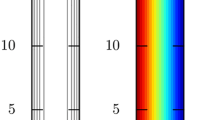Abstract
The problem of the separation of phases of different density in a porous medium in a gravitational field is considered. In describing the segregation process in a very thick bed the capillary pressure may be neglected as compared with the gravitational pressure drop due to the difference in phase densities. In this formulation the problem is a similarity one, but permits a complete analytic investigation with a qualitative analysis of the process on the basis of the exact solutions. The exact solutions of problems of gravitational segregation in beds of limited thickness derived in this study are nonself-similar in character, which distinguishes them from the results for an unbounded bed previously obtained [1]. Taking capillarity into account gives a fuller picture of the phenomenon. A corresponding description and analysis based on numerical solutions are given in [2, 5]. It is characteristic of the problems examined here that for the first-order quasilinear hyperbolic equation describing the segregation process two boundary conditions are formulated. These conditions correspond to the impermeability of the roof and floor of the bed.
Similar content being viewed by others
Literature cited
I. A. Charnyi, Underground Hydrogasdynamics [in Russian], Gostoptekhizdat, Moscow (1963).
M. I. Shvidler and B. I. Levi, One-Dimensional Filtration of Immiscible Fluids [in Russian], Nedra, Moscow (1970).
A. Courant and K. O. Friedrichs, Supersonic Flow and Shock Waves, New York (1948).
R. D. Kanevakaya, M. V. Lur'e, V. M. Makismov, and M. V. Filinov, “Exact solution of the problem of the cyclic energy of underground gas storage,” Inzh.-Fiz. Zh.,44, 657 (1983).
V. M. Ryzhik and A. Ya. Khavkin, “Model using capillary hysteresis to investigate the process of capillary-gravitational segregation in an oil bed,” in: Physical and Mathematical Modeling of Oil and Gas Production Mechanisms [in Russian], Nauka, Moscow (1981), pp. 38–44.
P. G. Bedrikovetskii and Ya. E. Dorfman, “Nonlinear waves in two-phase three-component filtration processes,” Dokl. Akad. Nauk SSSR,264, 60 (1982).
P. G. Bedrikovetskii, R. D. Kanevskaya, and M. V. Lur'e, “Nonequilibrium sorption, solution and heat transfer effects in the displacement of oil by active fluids,” Dokl. Akad. Nauk SSSR,266, 1324 (1982).
M. G. Bernadiner, V. M. Entov, and A. V. Ugoleva, “Developed stage of unstable displacements in a porous medium,” Dokl. Akad. Nauk SSSR,245, 320;245, 312 (1979).
Author information
Authors and Affiliations
Additional information
Translated from Izvestiya Akademii Nauk SSSR, Mekhanika Zhidkosti i Gaza, No. 2, pp. 88–97, March–April, 1986.
Rights and permissions
About this article
Cite this article
Bedrikovetskii, P.G., Maron, V.I. Gravitational separation of oil and water in beds of limited thickness. Fluid Dyn 21, 242–251 (1986). https://doi.org/10.1007/BF01050176
Received:
Issue Date:
DOI: https://doi.org/10.1007/BF01050176




